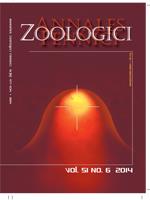Urbanization and subsequent disturbance, habitat alteration and fragmentation are usually seen as major threats to biodiversity. However, habitat alterations might also create new habitat types that can be used by the local fauna. Here, we tested whether hole-nesting passerines use forest edges next to open grassland areas for reproduction by assessing five golf courses in the Helsinki region in southern Finland. We found a major effect in all species breeding at our sites (great tit, Parus major; blue tit, Cyanistes caeruleus; pied flycatcher, Ficedula hypoleuca): both nest occupancy and the number of offspring were significantly higher at the artificial edges than 50 m into the original forests. We conclude that man-made suburban forest edges provide suitable habitat for nesting, which could be further improved with the addition of nest boxes.
How to translate text using browser tools
29 December 2014
Do Hole-Nesting Passerine Birds Fare Well at Artificial Suburban Forest Edges?
Jarmo Saarikivi,
Gábor Herczeg
ACCESS THE FULL ARTICLE

Annales Zoologici Fennici
Vol. 51 • No. 6
December 2014
Vol. 51 • No. 6
December 2014




